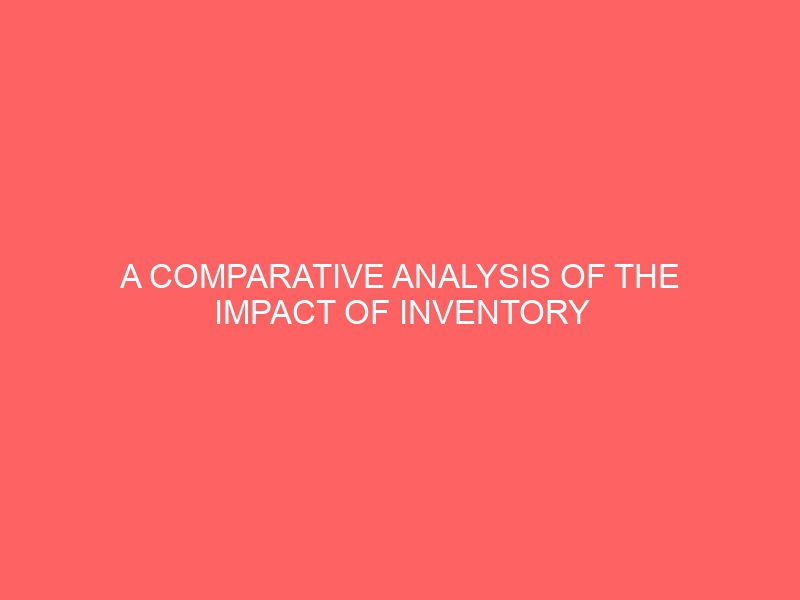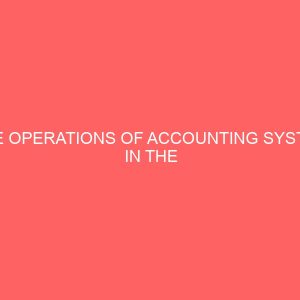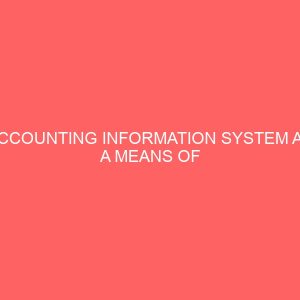A COMPARATIVE ANALYSIS OF THE IMPACT OF INVENTORY VALUATION METHODS ON FINANCIAL REPORT STATEMENT IN SOME MANUFACTURING COMPANIES IN ENUGU STATE
ABSTRACT
This research work was conducted on with special reference to the impact inventory valuation methods has on financial report statements of manufacturing companies. For a longtime now the Accounting profession has not been able to come up with any particular technique or method to be used uniformly in valuing inventory. This research work examined if the method used was as a result of the prevailing economic circumstances. A survey research design was adopted for the study; data collected were gotten from both the primary and secondary sources. An infinite population of over 3000 was used and a finite population of 220. Three hypotheses were tested at 5 percent level of significance. Tables and percentages were employed to answer the questionnaires while the statistical regression coefficient analysis and Z test were used to test the hypotheses. It was found amongst others that the prevailing economic parameter influences the decision of choice of inventory valuation method used. The Accounting professional bodies should try as much as possible to adopt a particular method of inventory valuation and the weighted average method was recommended as a method that can withstand any economic challenges
CHAPTER ONE
1.0 INTRODUCTION
1.1 BACKGROUND OF THE STUDY
Inventory valuation allows companies to provide a monetary value for items that make up their inventory stock.
Inventories are usually the largest current asset of a business and are as important as funds cash. It is a form of fund tied up in assets current assets. Its proper or accurate measurement or valuation cannot be overlooked as it forms a greater percentage of an enterprises current assets in particular and a total asset in general. For manufacturing companies, inventories usually represent approximately 20 to 60 percent of their assets. If inventory is not properly valued, it may result that expenses and revenue may as well not be properly matched and a company could make poor business decisions that will affect the companys profit. It is essential the way assets are valued because it could be attributable to the numerous benefits which an organization stands to gain by keeping an accurately valued stock that meet shareholders needs, demands for financial information and also the relevant specification of a particular organization. However, it will be a waste of time if the record accuracy is poor.
Inventory in manufacturing company or concern comprises of the following components:
Raw materials inventory
Work in progress semi finished goods inventory
Finished goods inventory
These components show the relationship between production and sales, and it enables an organization to offer better service to its customers at a reasonable price.
However, the technique or method used in the valuation of inventories varies and the values placed on inventories vary in time with the prevailing economic parameters inflation, deflation or static economy and it can also be influenced by the management policy of the organization. For instance, if the objective of an enterprise is that of profit maximization, it may result to the use of a particular method so as to disclose lower profit, thereby using excess fund at its disposal to expand its operations. This type of organization may discard other methods of valuing inventories in favour of the method that suit it objectives.
According to Nwoha 2006:69, no area of accounting has produced wider difference in practice than the computation of amount at which inventories stocks and workinprogress as stated in financial account.
1.2 STATEMENT OF THE PROBLEMS
For a long time now the accounting profession has not been able to come up with any particular techniques to be used uniformly in valuing inventories. Various accounting bodies strongly recommend one method or the other. As each method used has its effect on profits and closing inventory figures. This paves way to differing tax assessments and brings about a situation whereby some organizations are over assessed overtaxed while others are under assessed. This also bedevils the comparability of one firms performance with that of another though they may be in the same line of business when an investor is attempting to invest his capital in a firm.
However, each body or organization purports being consistent with the use of certain valuation methods yet some companies adopt the method which gives them advantage over any other recommended method or method accepted by the Board of Internal Revenue, or Federal Board of Inland Revenue for tax assessment purposes. The method adopted by the companies enables them to pay less tax to the government. The problem in achieving a statutory consensus compliance method in the administration of inventory valuation by Nigerian manufacturing industry has persisted. An appropriate forum of diverse accounting professional bodies is required to reach a consensus on the issues of choosing and adopting appropriate inventory valuation methods for each group of industry. Hence, thisresearch work is a step in the right direction to address the role of accounting professional towards the achievement of the objective.
1.3 OBJECTIVES OF THE STUDY
The aim of this research work includes the following:
1. To determine whether inventory valuation methods have any impact on the assessable income tax of Nigerian manufacturing company.
2. To ascertain whether the prevailing economic parameters influences the inventory valuation method used by Nigerian manufacturing company.
3. To determine whether variances in inventory valuation methods affect financial reporting positions of Nigerian manufacturing company.
4. To provide an acceptable basis for valuing inventory on hand.
5. To evaluate certain limiting factors faced by accountants in inventory valuation.
1.4 RESEARCH QUESTIONS
The following questions are formulated for the purpose of this study;
1. Does an inventory valuation method have any impact on the assessable income tax of Nigerian manufacturing company
2. What influence does the prevailing economic parameter have on the inventory valuation method used by Nigerian manufacturing company
3. To what extent does the variance in inventory valuation method affect financial reporting positions of Nigerian manufacturing companies
1.5 HYPOTHESES
The following hypotheses are formulated to help achieve the purpose of the study:
HYPOTHESIS ONE
H0: inventory valuation methods do not have any impact on the assessable income tax of Nigerian manufacturing companies.
H1: inventory valuation methods have an impact on the assessable income tax of Nigerian manufacturing companies.
HYPOTHESIS TWO
H0: the prevailing economic parameters do not influence the inventory valuation methods used by Nigerian manufacturing companies.
H1: The prevailing economic parameter influences the inventory valuation methods used by Nigerian manufacturing companies.
1.6 SIGNIFICANCE OF THE STUDY
The proper valuation of stock inventory cannot be over looked. This research work is significant in the following ways:
1. It will determine if inventory valuation methods play any significant role in ensuring the firms accountability.
2. It will determine the role of account department of a firms inventory valuation.
3. It will xray what true and fair means with regard to inventory valuation.
4. It will determine the causes of misrepresentation of true and fair view of financial statement of firms and usher useful suggestions to stop the practice.
5. It will offer useful suggestions towards making the store manager more efficient in preparing or advancing adequate data that will lend credibility to a true and fair view of a firms operation and financial statement.
1.7 SCOPE OF THE STUDY
This research work will be limited to the use of questionnaire and oral interview where appropriate and to a review of related literature relevant books, journals, etc. that would provide adequate and lasting solution to the problem of inventory valuation. Data collection will be restricted to three manufacturing companies which are Emenite limited, Innoson industrial and technical company limited and Alo aluminum manufacturing company all in Enugu state.
Furthermore, the study is equally limited to the study of the impact of the different methods on inventory valuation on companys financial statement with particular reference to its effect on:
Tax assessable profits on companies.
Amount of tax payable by firms under the different methods,
The cost of goods sold value reported under the methods,
Closing stock values reported under these methods,
The decision of the potential and actual investors in the companies based on available divisible profits.
1.8 LIMITATIONS OF THE STUDY
In carrying out this research project, the researcher encounters problems which may be attributed to;
1. Unreliable or irrelevant information obtained from oral interviews. This was based on the degree of the respondents truthfulness in answering the questions asked during the oral interview. Some respondent thought the research was to expose their company and thus were unwilling to give adequate and relevant information.
2. As a result of time the researcher was restricted to just the LIFO LastIn, FirstOut, FIFO FirstIn, FirstOut and the WAM Weighted Average method of inventory valuation.
3. The researcher encountered the problem of not getting back all the questionnaires administered to respondents for responses.
1.9 DEFINITION OF TERMS
A. INVENTORY
This is also known as stock. These are assets held for sale in the ordinary course of business, in the process of production for such sale; or in the form of materials or supplies to be consumed in the production process or in rendering of services.
B. FINANCIAL STATEMENTS
These are statements produced at the end of accounting periods, such as income statement, cash flow and statement of financial position. They are reports which summarize the financial position. They are reports which summarize the financial position and operating results of a business.
C. CONSISTENCY IN INVENTORY VALUATION
This is an accounting standard which demands for the use of the same method of inventory pricing valuation from year to year, with full disclosure of the effect of any change in method to enhance the comparability of financial statements presented in the annual report.
D. MANUFACTURING COMPANIES
These are establishments that combine men, materials and machinery in an effective manner with the aim of producing goods for human consumption and also to make profit for the on going of the business.
REFERENCES
Omolehinwa, E. O 2011.Coping with Cost Accounting 2nd Edition Pumark Nigeria Ltd.
Adeniyi, A.A2009.Cost Accounting; A managerial approach. El Toda ventures ltd.
Horngren,E.T1982.Cost Accounting. A managerial emphasis 5th Edition London: Prentice hall.
Lucy, T 1984. Costing; An instructional manual,Eastheigh Hants: D. P publications
Original price was: ₦3,200.00.₦3,000.00Current price is: ₦3,000.00.








Reviews
There are no reviews yet.